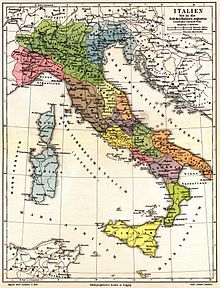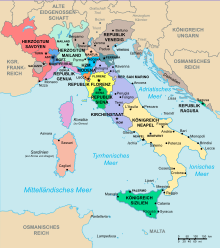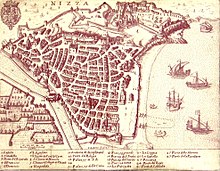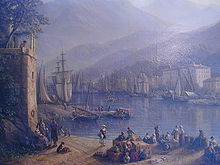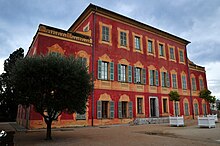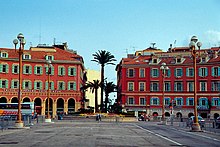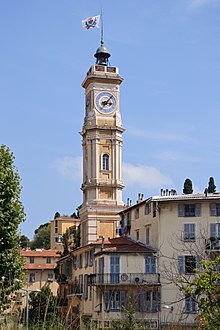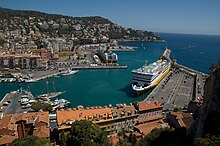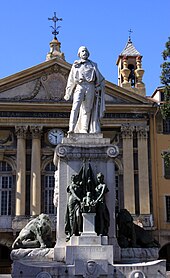Nice
|
Nice German Nice |
||
|---|---|---|

|
|
|
| region | Provence-Alpes-Cote d'Azur | |
| Department | Alpes-Maritimes ( prefecture ) | |
| Arrondissement | Nice | |
| Canton |
Nice-1 Nice-2 Nice-3 Nice-4 Nice-5 Nice-6 Nice-7 Nice-8 Nice-9 |
|
| Community association | Nice Cote d'Azur | |
| Coordinates | 43 ° 42 ′ N , 7 ° 16 ′ E | |
| height | 0-520 m | |
| surface | 71.92 km 2 | |
| Residents | 340,017 (January 1, 2017) | |
| Population density | 4,728 inhabitants / km 2 | |
| Post Code | 06000, 06100, 06200, 06300 | |
| INSEE code | 06088 | |
| Website | www.nice.fr | |
Nice ( French Nice [ nis ], nissart Nissa / Niça , Italian Nice ) is a port city in the southeast of France in the region Provence-Alpes-Côte d'Azur (PACA), 30 kilometers from the border with Italy between Cannes and the Principality Monaco is located on the Côte d'Azur on the Mediterranean Sea . Nice is the seat of the prefecture of the Alpes-Maritimes department . Together with 48 other municipalities, Nice forms the Métropole Nice Côte d'Azur . With 342,295 inhabitants (as of 2013), Nice is the second largest city in the Provencal region of PACA after Marseille and the fifth largest city in France . The population including the surrounding area is 930,000.
geography
Nice is located in south-east France and in the direct extension of the Mercantour massif ( Maritime Alps ), bounded to the west by the Var valley and to the east by Mont Boron. The distance to the Principality of Monaco is about 10 kilometers, the distance to the Italian border 30 kilometers.
Language and population
The inhabitants of Nice are known as Nizza , in French Niçois . In the country of Nice, an Occitan or Provencal dialect is still sometimes spoken, the so-called Nissart or Niçard , in the standard language Niçois , which most recently probably went back to a mixture of the native Ligurian dialect with the Latin of the Roman conquerors.
Climate and local geography
Thanks to its protected location, Nice is one of the warmest places on the French Côte d'Azur even in winter. The most pleasant months to travel are May and mid-September to mid-October. In general, the temperatures in Nice are a few degrees above the temperatures in Germany. The months June to August can get very hot. The winters are mild and there is hardly any frost in Nice. This is why this city was a popular winter quarter for the British and Russians, including the tsarist family, in the 19th century . The large hotels and gardens as well as the Orthodox Church still bear witness to this fact today. Nice does not have a sandy beach, but a stone beach. The mild climate favors viticulture, the wine-growing area around Nice is called Bellet .
| Nice | ||||||||||||||||||||||||||||||||||||||||||||||||
|---|---|---|---|---|---|---|---|---|---|---|---|---|---|---|---|---|---|---|---|---|---|---|---|---|---|---|---|---|---|---|---|---|---|---|---|---|---|---|---|---|---|---|---|---|---|---|---|---|
| Climate diagram | ||||||||||||||||||||||||||||||||||||||||||||||||
| ||||||||||||||||||||||||||||||||||||||||||||||||
|
Average monthly temperatures and rainfall for Nice
Source: Météo-France
|
|||||||||||||||||||||||||||||||||||||||||||||||||||||||||||||||||||||||||||||||||||||||||||||||||||||||||||||||||||||||||||||||||||||||||||||||||||||||||||||||||||||||||||||||||||||||||||||||||||
history

The area of what is now Nice was populated by Homo erectus 400,000 years ago . During excavation work in 1965, numerous artefacts were found that are now on display in the Terra Amata Museum. 190,000 to 130,000 years ago Neanderthals lived here , the remains of which have been excavated in the Grotte du Lazaret .
Probably around 350 BC The Phocaeans from the area around Marseille defeated the Ligurians and founded Νίκαια Níkaia ("the victorious", after the goddess of victory Nike ). In 154 BC The Romans established themselves in the area after the Greek settlements of Nikaia and Antipolis, today's Antibes , were attacked by Ligurians from the area of Biot and Cannes. To secure the region, the Romans built a second settlement next to Nikaia, Cemenelum , on the mountains of Cimiez. The ruins that have been preserved indicate a population of 15,000 to 20,000 for Cemenelum (today's district of Cimiez ). The place was thus a regional administrative center and experienced an upswing in particular through the construction of the Via Julia Augusta (7 BC), so that around this time the base grew into the city.

In the fifth century, Cemenelum was abandoned in favor of Nikaia . Provence fell to the Ostrogoths in 508 and to the Frankish Empire in 536 . In 813, 859 and 880 Nice was sacked by Saracen invaders who came from the sea. In the following period (e.g. in 943) the city was exposed to attacks by the Muslims. These had established themselves in the nearby Fraxinetum from 888 to around 975 before Count Wilhelm of Provence could drive them out.
In 1144 a city council ("Consulat") is mentioned, in 1176 a first city constitution. Nice, however, remained subordinate to the county of Provence, so that the city was Aragonese in the 12th century and belonged to the Anjou family from 1246 . In the 13th century the competition with Genoa became increasingly noticeable, which even briefly gained sovereignty over the city around 1215. In response, the Count of Provence had a fleet stationed in Nice around 1250. In 1295 the city of Villefranche (as much as Free City ) was founded near Nice with a base to combat piracy. In 1385, after the death of the landlady Johanna I , the succession was torn when Karl von Anjou and his cousin Karl von Durazzo claimed the county of Provence for themselves. In this situation Nice turned against the Anjous at the instigation of Mr. Jean Grimaldi , whereupon in 1388 Duke Amadeus VII of Savoy transferred the eastern part of Provence as Terre Neuve de Provence and later as the county of Nice (French Comté de Nice ) to his duchy incorporated, which thus gained access to the sea. Due to its strategic location, the city was heavily fortified and was repeatedly contested as a result.

In 1524, Francis I of Valois-Angoulême crossed the county of Nice to fight the French claims in Lombardy against the Habsburgs . In the battle of Pavia, however, he was captured by Charles V , who had him brought to Spain by ship from Villefranche in 1525. In 1536 the Duke of Savoy withdrew to the county of Nice before the King of France . Two years later in Nice with the mediation of Pope Paul III. an armistice negotiated between Francis I and Charles V. In 1543 Nice was besieged and sacked by French troops and the fleet of Khair ad-Din Barbarossa ; the citadel could be held. According to local tradition, it was a laundress, Catherine Ségourane , who, as a “Joan of Arc of Nice”, is said to have forced the Turks to leave.

In 1600, Henry IV besieged the city. On the occasion of the Peace of Lyon in 1601, Nice remained with the Duchy of Savoy, which established one of the country's three courts of law here in 1614. In 1631 Nice was hit by a plague epidemic. In 1642 the Spaniards were expelled from Nice. In 1691, Louis XIV took Nice and the region, and at the same time took on the title of Count of Nice. In 1693 the military architect Sébastien Le Prestre de Vauban visited the region around Nice to organize the repair of the fortifications. Two years later, the Duke of Savoy regained the county of Nice through the marriage of his daughter to a grandson of Louis XIV. During the War of the Spanish Succession there was renewed fighting in the region, as Savoy sided with the Habsburgs against France. However, a French attack under General Catinat led to the extensive destruction of the fortress.
In 1744, as part of the War of the Austrian Succession , French-Spanish troops conquered the county, which, however, was again given to Savoy in the Peace of Aachen of 1748. In 1749 the Lympia basin, today's port, was created. After a referendum in 1793, the county was annexed to France and raised to the 85th Département with the name Alpes-Maritimes .
From here Napoleon Bonaparte began his Italian campaign in 1796 , which led to the occupation of Piedmont . In 1800 the region was briefly occupied by Austrian troops, but after Napoleon's victory in the Battle of Marengo it was again placed under French rule. In 1804 Nice recognized the Empire by 3,488 to 2 votes. In the First Peace of Paris in 1814, the county of Nice reverted to Piedmont, which had meanwhile become part of the Kingdom of Sardinia . The borders of 1760 were thus restored. In 1859, France supported the national unification of Italy achieved against the Habsburgs under the rule of the King of Sardinia-Piedmont , Napoleon III. but had to admit the final annexation of Savoy and Nice to France in the Treaty of Turin . This was approved by the people of Nice in a plebiscite with around 25,000 votes against just about 200. The railway ( PLM - Chemins de fer de Paris à Lyon et à la Méditerranée ) reached the city in 1864. Since the station was built far outside the city in the open field, construction activity shifted to the area across the River Paillon . The old town was thus well preserved. In 1882 the French architect Charles Garnier built the Nice observatory .
In the meantime, the city was so well established as a summer resort for the British that Alexandre Dumas declared in 1851 that Nice was basically an English city where you could meet a local every now and then. The European nobility, such as the Russian Tsar and Victoria of Great Britain, also increasingly stayed here . While around 22,000 guests spent the winter here around 1890, by 1910 there were already 150,000.
The boom as a tourist destination was accompanied by a corresponding industrialization, which increasingly attracted Italian guest workers in the 20th century, who mainly settled in the Riquier and Madeleine districts. During the Second World War, the city, which was initially occupied by Italians and later by Germans, remained largely undamaged; Resistance centers were located in the mountains above the city . While the proportion of British in the city gradually declined, that of immigrants from the former French colonies increased, especially after World War II. In 2000 the Treaty of Nice was passed in the city .
During the national holiday celebrations on the evening of July 14, 2016, a truck drove around two kilometers into a crowd on the Promenade des Anglais . 86 people were killed and more than 200 people were injured, some seriously. The driver, a 31-year-old Tunisian resident of Nice, was killed by police in an exchange of fire.
Population development
| year | 1962 | 1968 | 1975 | 1982 | 1990 | 1999 | 2006 | 2017 |
| Residents | 292,958 | 322,442 | 344,481 | 337.085 | 342,439 | 342,738 | 347.060 | 340.017 |
| Sources: Cassini and INSEE | ||||||||
coat of arms
Description: In silver, a completely crowned red eagle with red clover stalks on the wings stands on a black three-mountain , which protrudes from a blue wave shield base and shows roof-tile-shaped waves.
Culture and sights
architecture
As a result of its checkered past, the city of Nice has developed a rich architectural heritage. By concentrating the construction activity on the city expansion in the Second Empire, the old town center remained largely intact. Many villas, palaces and baroque churches were also built in the Savoy era and have been preserved. A special feature is the vaulting of the Paillon River , which was carried out in several historical stages from 1868 onwards . It made it possible to create significant green areas in what is now the central area of the city, and some of the areas thus gained also served as the construction site for large public buildings. The Belle Époque before 1914 also left clear traces in Nice.
Museums
Nice has many museums dedicated to art, history or local traditions. The variety of the different museums consolidate Nice's reputation as an art metropolis. Entry to the city's museums was free from July 1, 2008 to 2014. This now only applies to residents of the Provence-Alpes-Cotes d'Azur region.
Art museums
The Musée des Beaux-Arts on Avenue des Baumettes has collections from the late 16th century to the mid 20th century. It was opened in 1878 and is mainly home to paintings by French artists, including Jules Chéret, who died in Nice . The styles on display are Mannerism ( Bronzino ), Rococo ( van Loo , Fragonard ), Impressionism ( Sisley , Monet ), Post-Impressionism ( Vuillard , Bonnard ) and Fauvism ( van Dongen , Dufy ).
The Musée Matisse is located in a Genoese residence of the 17th century on Mount Cimiez, with the private collection of Henri Matisse , who lived here for most of his life from 1917 until his death in 1954. Opened in 1963, it has since housed a permanent collection of 218 prints, 57 sculptures, 68 paintings, 95 photos, 236 drawings, 14 illustrated books and 187 objects that were Matisse's property, such as serigraphs, tapestries, ceramics, stained glass windows and documents.
The Musée Message Biblique Marc Chagall in Cimiez houses a collection of 17 works by Marc Chagall, which were created during the artist's lifetime. It deals with biblical subjects and shows Genesis , Exodus and the Song of Songs . It was inaugurated in 1973.
The Musée d'Art Moderne et d'Art Contemporain (MAMAC), opened in 1990, brings together works by New Realists ( Yves Klein , Jean Tinguely , Christo and Jeanne-Claude , Niki de Saint Phalle , César , Arman , Martial Raysse ) and Pop Art - Artists ( Andy Warhol , Roy Lichtenstein , Tom Wesselmann , Robert Indiana , Jim Dine ) and representatives of American abstraction ( Frank Stella , Sol LeWitt ). The museum is also often used for temporary exhibitions.
In the L'Arenas business district on the Promenade des Anglais, opposite the airport, is the Musée des Arts Asiatiques , a modern building by the architect Kenzō Tange . It has collections of Buddhist art and exhibitions on the art of Asia. His approach is historical, artistic and ethnological.
The Musée International d'Art Naif Anatole Jakovsky with works of folk art from the 17th to the 20th centuries was inaugurated in 1982. The collection comes from donations from Anatole and Renée Jakovsky.
History museums
The Musée de Paléontologie Humaine de Terra Amata houses the artefacts, which are among the oldest known dwellings in Western Europe and are around 400,000 years old, which were found in 1965 during excavation work over the old port.
The Musée Archéologique de Cimiez shows the finds from the archaeological excavations in the Roman settlement of Cimiez.
The Musée de la Résistance azuréenne is dedicated to the resistance of the Alpes-Maritimes region against the German occupation in World War II.
The Musée Masséna shows the varied history of Nice.
Other museums
The Musée d'Histoire Naturelle de Nice , which opened in 1846, is the oldest museum in the city. It has collections from the nineteenth century put together by local naturalists. Birds, shells, minerals, fossils and flowering plants and mushrooms from Nice are on display. The museum is to be relocated to the Cité des Sciences et de la Nature in the future. It was expected to open in mid-2013.
The Musée de la Marine , located in the Bellanda Tower, houses paintings, models of ships and ships' navigational instruments.
The Musée Prieuré du Vieux-Logis houses a collection of Gothic and Renaissance furniture and objects of religious art.
Cultural institutions
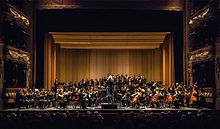
Orchester Philharmonique de Nice
The Orchester Philharmonique de Nice ( Nice Philharmonic Orchestra) is the orchestra of the city of Nice and is considered one of the leading opera and symphony orchestras in France. It was officially founded in 1945 as "L'Orchestre Symphonique Municipal de la Ville de Nice" (Symphony Orchestra of the City of Nice).
Center Cinématographique
The Center Cinématographique in Nice, along with the Philharmonic Orchestra, is one of the city's most important cultural institutions. The aim of the film center is to build a bridge between theoretical training at universities and the requirements of everyday production. It also manages an inventory of audiovisual media on historical topics, political education, business, art and culture.
Buildings
There are numerous baroque buildings in the well-preserved old town . Among the churches include the Cathedral Sainte-Reparate from the 17th century, but the facade dates from 1825, the Annunciation Church ( Sainte-Rita ) , the Église du Gésu , the church Saint-Martin-Saint-Augustin or Église la Misericorde .
Furthermore, secular buildings stand out such as the prefecture, once the seat of the Dukes of Savoy, or the Palais communal as the former town hall. This was built in 1580 and a monumental portal was added by Marc'Antonio Grigho in the 17th century. Above the old town is the castle hill ( Colline du Château ) with the ruins of the citadel, which was razed in 1706.
The Place Garibaldi and the Place Masséna , both single design space systems according the Turin models, make the transition to the new city. It is characterized by numerous luxury hotels, apartment houses and villas from the Belle Époque . The most famous hotel is the Negresco . On the south side of the new town is the Promenade des Anglais , a boulevard built between 1822 and 1824.
The growth of the Russian community since the second half of the 19th century led to the construction of Orthodox churches. The first Russian church, Saint-Nicolas-et-Sainte-Alexandra , was built in 1858 by the architect Antoine-François Barraya. In 1912 the architect Preobrajensky built the Russian Orthodox Saint-Nicolas Cathedral , the largest outside of Russia, on behalf of Tsar Nicholas II . It is located in the place where the Tsarevich Nikolai Alexandrovich Romanov died in 1865 .
The excavations of the Roman city can be visited on Mount Cimiez. There is also a Franciscan monastery with paintings by Jacques Bréa and the cemetery where Henri Matisse is buried. The German Church in Nice has existed since Italian times.
Events
Every year in February, held on the occasion of the carnival at Nice's showpiece street Promenade des Anglais of became known in the rest of Europe Blumenkorso instead of festively decorated floats and countless flower arrangements.
Sports
The city is home to the OGC Nice football club , which plays in Ligue 1 . The traditional club has won the French football championship four times and the French cup three times . The game was played in the Stade Municipal du Ray until September 2013, when it was replaced by the new construction of the Stade de Nice in the west of the city.
Nice is also the stronghold of water polo in France. The ONN (Olympique Nice Natation) has won the championship twelve times in the last 15 years.
Until 2001 Nice was also a city of traditional rugby , but the Racing Rugby Club de Nice (RRCN) had to relegate due to financial problems.
Nice is the destination of the Paris-Nice cycle race , the starting point of the Marathon des Alpes-Maritimes , as well as the venue for the ATP Nice Tennis Open , the Ironman France and the World Figure Skating Championships in 2000 and 2012.
Economy and Infrastructure
The economy is dominated by tourism and high technology. The Sophia Antipolis technology center is located approx. 20 km west of the city.
traffic
About seven kilometers west of the city center is Nice International Airport , which is the third largest in France with 13.8 million passengers (2018) (see list of airports in France ). There are regular ferry connections to the island of Corsica . The city is connected to the long-distance network of the SNCF . The Nice-Ville long-distance train station is located in the city center, 500 m north of the Chemins de fer de Provence train station , which connects the cities of Nice and Digne-les-Bains . Local public transport in the agglomeration is carried out by the operating company Lignes d'Azur with more than 70 bus routes. There are also numerous regional bus connections ( TAM, Transports des Alpes-Maritimes ) to the surrounding area.
Since November 2007 a tram has been operating again in Nice after a long interruption ; Another line (Ligne 2), which runs along Rue de France, i.e. parallel to the Promenade des Anglais on the Mediterranean coast and, after an above-ground connection to the airport, leads underground to the port of Lympia after the Magnan stop, was opened in 2018 (towards the airport) or . Opened in 2019 (towards the port). Completion was delayed due to numerous unforeseen price increases in tunnel construction. Line 3, which connects the Stade de Nice , also opened at the end of 2019. A fourth line is also being considered.
education
- University of Nice Sophia-Antipolis
- EDHEC Business School
- École pour l'informatique et les nouvelles technologies
- Institut supérieur européen de formation par l'action
Twin cities
Nice has developed a wide network of partnerships. The city differentiates between active and other partnerships.
|
|
Personalities
Famous personalities from Nice include the Italian guerrilla fighter Giuseppe Garibaldi , the politician and President of the European Parliament Simone Veil and the Nobel Prize winner for literature Jean-Marie Gustave Le Clézio .
useful information
Since 1860, a cannon has been fired at full volume from the Château east of the old town every day at 12 noon. This tradition goes back to Sir Thomas Coventry, who, with the support of the Mayor, wanted to encourage a punctual lunch for the residents.
literature
- travel Guide
- Ralf Nestmeyer : Côte d'Azur . Travel guide. Michael-Müller-Verlag, 7th edition, Erlangen 2012, ISBN 978-3-89953-680-5 .
- Jens Rosteck : Instructions for use for Nice and the Côte d'Azur. Piper, Munich 2007. 3rd edition, Munich 2013, ISBN 978-3-492-27554-5 .
- Britta Sandberg : Côte d'Azur. With cards. 5th updated edition. DuMont Reiseverlag Ostfildern 2016, ISBN 978-3-7701-7359-4 .
- Barbara F. Freed and Alan Halpern: Artists and their museums on the riviera. Harry N. Abrams, New York 1998, ISBN 0-8109-2761-6 (pbk.). With numerous illustrations and bibliography. (English-language guide to all museums, churches, chapels, collections, works of art and houses as well as gardens of the artists on the Côte d'Azur with the art of the 20th century by Cocteau , Picasso , Léger , Renoir , Chagall , Matisse , Jakovsky.)
Web links
|
Further content in the sister projects of Wikipedia:
|
||
|
|
Commons | - multimedia content |
|
|
Wiktionary | - Dictionary entries |
|
|
Wikisource | - Sources and full texts |
|
|
Wikivoyage | - Travel Guide |
- Official website of the city of Nice
- Nice Tourist Office (multilingual)
Individual evidence
- ^ Number from the French Statistical Office ( memento of February 5, 2013 in the Internet Archive ), accessed on February 2, 2012
- ↑ Population development , accessed on October 5, 2013.
- ^ France: A Russian cathedral in Nice
- ^ Homepage of the Musée des Beaux-Arts de Nice
- ↑ Musée Matisse , nice.fr, accessed on February 11, 2013 (French)
- ↑ Le Musée d'Art Moderne et d'Art Contemporain (French)
- ↑ Homepage of the Musée départemental des Arts Asiatiques (French)
- ↑ Website of the Musée Archéologique de Cimiez (French)
- ↑ Le Musée de la Resistance Azuréenne
- ↑ Le Guide Vert Michelin, Côte d'Azur Monaco. 2007, p. 300.
- ↑ Villes jumelées avec la Ville de Nice. In: City of Nice website. Archived from the original ; Retrieved April 3, 2010 (French).
- ↑ See the article on the English-language information platform francemonthly.com : Nice - French Riviera: Noon on the Dot ( Memento from April 11, 2013 in the web archive archive.today ). Retrieved February 11, 2013.




